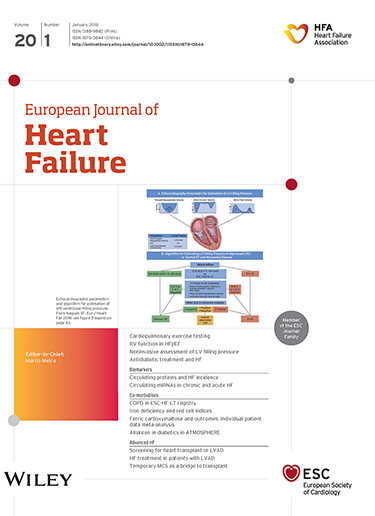Nationwide implementation of heart failure therapies: National Heart Failure Center Accreditation Program (HF-CAP) in China.
IF 10.8
1区 医学
Q1 CARDIAC & CARDIOVASCULAR SYSTEMS
引用次数: 0
Abstract
AIMS Implementing optimal guideline-directed medical therapy is still challenging in patients with heart failure (HF). This prospective study assessed the benefits of large-scale, nationwide, multi-annual implementation of HF therapies in China. METHODS AND RESULTS This longitudinal, pre-post comparison design included patients in hospitals accredited by the National Heart Failure Center Accreditation Program (HF-CAP). Patients were divided into four groups: 6-12 months before accreditation (Pre); >0 -≤12 months after accreditation (Y1); >12-≤24 months after accreditation (Y2), and >24 months after accreditation (Y2+). The primary endpoint was 1-year composite HF readmission and/or cardiovascular death. Secondary endpoints included 1-year HF readmission alone, 1-year cardiovascular death alone, and association between phone calls and/or visits and outcomes. Overall, 408 073 patients with HF from 646 centres were included. After HF-CAP accreditation, more patients with HF were treated following discharge. Compared with the Pre group, risk of meeting the primary endpoint decreased in Y1 and was incrementally lower in Y2 and Y2+: fully adjusted odds ratios (OR) and 95% confidence intervals (CIs) were 0.893 (0.871-0.916), 0.855 (0.830-0.880) and 0.720 (0.695-0.745), respectively (all p < 0.0001). Risk of HF readmission alone reduced from Y1 onwards (OR 0.865 [95% CI 0.841-0.891]). Risk of cardiovascular death reduced from Y2 onwards (OR 0.942 [95% CI 0.904-0.983]). Phone calls had little association with patient outcomes; however, face-to-face visits reduced risk of cardiovascular death (OR 0.624 [95% CI 0.597-0.651]). CONCLUSIONS Guideline-directed medical therapy implementation and follow-up after HF hospitalization was achievable in ~400 000 patients and was associated with cardiovascular benefits 1-year post-initiation.心力衰竭治疗的全国实施:中国国家心力衰竭中心认证计划(HF-CAP)。
在心力衰竭(HF)患者中实施最佳的指导药物治疗仍然具有挑战性。这项前瞻性研究评估了在中国大规模、全国性、每年多次实施心衰治疗的益处。方法和结果这项纵向、前后比较设计纳入了国家心力衰竭中心认证计划(HF-CAP)认可的医院的患者。患者分为四组:前6-12个月(Pre);>0 -认证后≤12个月(Y1);>认证后12-≤24个月(Y2), >认证后24个月(Y2+)。主要终点是1年合并心衰再入院和/或心血管死亡。次要终点包括1年心力衰竭再入院,1年心血管死亡,以及电话和/或就诊与预后的关系。总共纳入了来自646个中心的408073例心衰患者。在HF- cap认证后,更多的HF患者在出院后接受治疗。与Pre组相比,Y1组达到主要终点的风险降低,Y2组和Y2+组达到主要终点的风险逐渐降低:完全调整的优势比(OR)和95%置信区间(ci)分别为0.893(0.871-0.916)、0.855(0.830-0.880)和0.720(0.695-0.745)(均p < 0.0001)。仅HF再入院的风险从1岁开始降低(OR 0.865 [95% CI 0.841-0.891])。心血管死亡风险从Y2开始降低(OR 0.942 [95% CI 0.904-0.983])。打电话与病人的预后关系不大;然而,面对面访问降低了心血管死亡风险(OR 0.624 [95% CI 0.597-0.651])。结论:约40万例心衰患者住院后可实现指南指导的药物治疗实施和随访,并在开始治疗后1年心血管获益。
本文章由计算机程序翻译,如有差异,请以英文原文为准。
求助全文
约1分钟内获得全文
求助全文
来源期刊

European Journal of Heart Failure
医学-心血管系统
CiteScore
27.30
自引率
11.50%
发文量
365
审稿时长
1 months
期刊介绍:
European Journal of Heart Failure is an international journal dedicated to advancing knowledge in the field of heart failure management. The journal publishes reviews and editorials aimed at improving understanding, prevention, investigation, and treatment of heart failure. It covers various disciplines such as molecular and cellular biology, pathology, physiology, electrophysiology, pharmacology, clinical sciences, social sciences, and population sciences. The journal welcomes submissions of manuscripts on basic, clinical, and population sciences, as well as original contributions on nursing, care of the elderly, primary care, health economics, and other related specialist fields. It is published monthly and has a readership that includes cardiologists, emergency room physicians, intensivists, internists, general physicians, cardiac nurses, diabetologists, epidemiologists, basic scientists focusing on cardiovascular research, and those working in rehabilitation. The journal is abstracted and indexed in various databases such as Academic Search, Embase, MEDLINE/PubMed, and Science Citation Index.
 求助内容:
求助内容: 应助结果提醒方式:
应助结果提醒方式:


